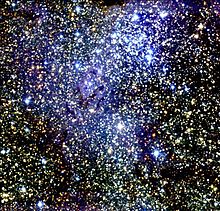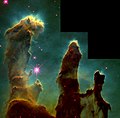Mgławica Orzeł
 Mgławica Orzeł, zdjęcie ESO | |
| Odkrywca | Jean Philippe de Chéseaux |
|---|---|
| Data odkrycia | 1745 lub 1746 |
| Dane obserwacyjne (J2000) | |
| Gwiazdozbiór | |
| Typ | |
| Rektascensja | 18h 18m 48,2s |
| Deklinacja | –13° 48′ 26″ |
| Odległość | |
| Jasność pozorna mgławicy | 6,4m |
| Rozmiary kątowe | 7' |
| Charakterystyka fizyczna | |
| Wymiary | 70×55 ly |
| Szacowany wiek | 5,5 mln lat |
| Alternatywne oznaczenia | |
| Messier 16, M16, NGC 6611, OCl 54, IC 4703, Sharpless 49 | |
 Gwiazdozbiór Węża | |
Mgławica Orzeł (również Messier 16, M16 lub NGC 6611) – gromada otwarta w gwiazdozbiorze Węża (w Ogonie Węża). W suplemencie do NGC, pojawia się też oznaczona IC 4703 mgławica emisyjna (być może obszar H II), otaczająca i rozświetlona przez M16. Oba obiekty są ze sobą powiązane, nazwa Mgławica Orzeł zwyczajowo dotyczy ich obu.

Gromadę otwartą M16 (NGC 6611) odkrył Jean Philippe de Chéseaux w roku 1745 lub 1746. Charles Messier odkrył ją niezależnie 3 czerwca 1764 roku i zasugerował jednocześnie istnienie mgławicy.
M16 jest jednym z najpopularniejszych obiektów astronomicznych, do czego niemało przyczyniły się jej sławne zdjęcia wykonane przez Kosmiczny Teleskop Hubble’a (tak zwane Filary Stworzenia).
Podstawowe dane
M16 znajduje się w odległości 7 tysięcy lat świetlnych (2,17 kpc) od Ziemi. Średnica kątowa mgławicy to 7 minut. Rzeczywista średnica gromady to 15 lat świetlnych, a cała mgławica ma rozmiary 70 × 55 lat świetlnych. Gromada gwiazd w M16 składa się z około 460 młodych gwiazd, których wiek szacowany jest na zaledwie 1-2 miliony lat. Naukowcy z Uniwersytetu Massachusetts, analizując obecne tam gwiazdy, dostrzegli obiekty o masie 3-8 mas Słońca, które dopiero rozpoczynają swoją ewolucję na ciągu głównym diagramu Hertzsprunga-Russella[1].
Jasność gromady to 6,4m. Jest niedostrzegalna gołym okiem, ale przy dobrych warunkach można ją zaobserwować przez lornetkę.
Sąsiedztwo z Mgławicą Omega
W bardzo bliskim sąsiedztwie M16, lekko na południe, znajduje się inny ciekawy obiekt, Mgławica Omega (M17), która również jest emisyjna. Studiując fotografie obu obiektów, można dostrzec między nimi wiele ciemnych plam. Są to prawdopodobnie liczne mgławice ciemne.
Galeria zdjęć z Teleskopu Hubble’a
- (c) ESA/Hubble, CC BY 4.0
„Filary” widziane w szerszym planie (2014)
„Wróżka” z Mgławicy Orzeł (2004)
Zobacz też
Przypisy
- ↑ Kamil Złoczewski: Wąż. Przewodnik obserwatora. Poznań: Amermedia Sp. z o.o., 2013, s. 20-23, seria: Kosmos. Tajemnice Wszechświata. ISBN 978-83-252-2118-8.
Bibliografia
- M16 w SEDS.org (ang.)
Linki zewnętrzne
- Mgławica Orzeł w bazie SIMBAD (ang.)
- The Eagle has risen: Stellar spire in the Eagle Nebula (ang.). W: Hubble [on-line]. ESA, 2005-04-25. [dostęp 2016-06-01].
- Courtney Seligman: NGC 6611 (ang.). W: Celestial Atlas [on-line]. [dostęp 2016-06-01].
Media użyte na tej stronie
Autor: Oryginalnym przesyłającym był Blueshade z polskiej Wikipedii, Licencja: CC-BY-SA-3.0
Ta mapa gwiazdozbioru została stworzona przy pomocy programu PP3 autorstwa Torstena Brongera. Tłumaczenia na język polski oraz innych modyfikacji na potrzeby polskiej Wikipedii dokonał Przemysław 'BlueShade' Idzkiewicz. Grafika udostępniona jest na licencji GFDL w wersji 1.2 lub nowszej.
Autor: ESO, Licencja: CC BY 4.0
Three-colour composite mosaic image of the Eagle Nebula (Messier 16, or NGC 6611), based on images obtained with the Wide-Field Imager camera on the MPG/ESO 2.2-metre telescope at the La Silla Observatory. At the centre, the so-called “Pillars of Creation” can be seen. This wide-field image shows not only the central pillars, but also several others in the same star-forming region, as well as a huge number of stars in front of, in, or behind the Eagle Nebula. The cluster of bright stars to the upper right is NGC 6611, home to the massive and hot stars that illuminate the pillars. The “Spire” — another large pillar — is in the middle left of the image. This image is a composite of 3 filters in the visible range: B (blue), V (green) and R (red).
(c) ESA/Hubble, CC BY 4.0
New view of the Pillars of Creation — visible
The NASA/ESA Hubble Space Telescope has revisited one of its most iconic and popular images: the Eagle Nebula’s Pillars of Creation. This image shows the pillars as seen in visible light, capturing the multi-coloured glow of gas clouds, wispy tendrils of dark cosmic dust, and the rust-coloured elephants’ trunks of the nebula’s famous pillars.
The dust and gas in the pillars is seared by the intense radiation from young stars and eroded by strong winds from massive nearby stars. With these new images comes better contrast and a clearer view for astronomers to study how the structure of the pillars is changing over time.
Credit:
NASA, ESA/Hubble and the Hubble Heritage Team
AAbout the Object
Name: Eagle Nebula, M 16, Messier 16
Type: • Milky Way : Nebula : Type : Star Formation
• X - Nebulae Images/Videos
Distance: 7000 light years
Constellation: Serpens Cauda
Colours & filters Band Wavelength Telescope Optical Oiii 502 nm Hubble Space Telescope WFC3 Optical H-alpha 657 nm Hubble Space Telescope WFC3 Optical Sii 673 nm Hubble Space Telescope WFC3.
Star forming pillars in the Eagle Nebula, as seen by the Hubble Space Telescope's WFPC2. The picture is composed of 32 different images from four separate cameras in this instrument. The photograph was made with light emitted by different elements in the cloud and appears as a different colour in the composite image: green for hydrogen, red for singly-ionized sulphur and blue for double-ionized oxygen atoms. The missing part at the top right is because one of the four cameras has a magnified view of its portion, which allows astronomers to see finer detail. The images from this camera were scaled down in size to match those from the other three cameras. Further information at: Credit: NASA, Jeff Hester, and Paul Scowen (Arizona State University)









